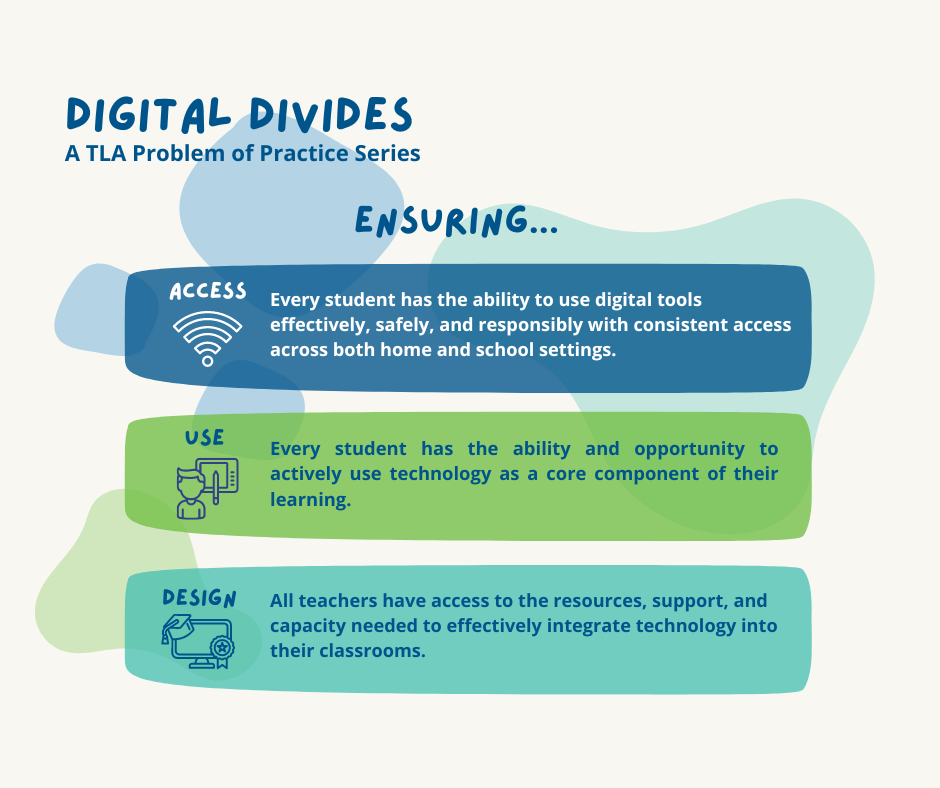
In January, the Office of Educational Technology released the 2024 National Educational Technology Plan (NETP). This latest iteration of the flagship federal edtech policy gave sweeping recommendations to do what we’ve always known is best for kids. In a moment when states, systems, and schools continue to grapple with the lingering effects of the pandemic, more devices and internet access than ever before, the blistering pace of advancements with artificial intelligence (AI), and the threat of an ESSR funding cliff, this federal document gives permission to do what educators and leaders have always known should happen – ensure that every student can access powerful learning opportunities and use technology in meaningful ways.
A Call to Action: Bridging the Digital Divides
Those of us who have been in the edtech space for the last few decades know that the goals of ubiquitous technology access and meaningful learning have always existed. In particular, over the past decade with the rapid adoption of mobile devices and expansion of high-speed broadband, we saw the potential for students to become creators and constructors of new learning artifacts; and yet, vast disparities emerged in terms of the Digital Use, Digital Design, and Digital Access Divides.
The NETP presents recommendations and guidelines to address these divides and help break technology out of its silo to drive learning forward. Enacting this plan requires collaboration across the education community so that ALL students have access to powerful devices and high-speed internet; build the recommended digital literacy, citizenship, and health skills; and have opportunities to actively use technology in meaningful ways. It also highlights the need to create enabling systems and structures to support this work.
the real challenge is helping educators and leaders do the hard work: make the plan a reality to close the divides in systems and classrooms.

From Federal Recommendations to Local Action: Steps to Drive Change
Meaningful change cannot happen in a single hour-of-code or within a discrete technology class. It requires investments in infrastructure, professional learning, and systems of support as well as shifts in instructional practice and the design of new learning opportunities. We realize that translating policy into practice requires educators and leaders to do hard work at a time when resources and energy may be at an all-time low. For that reason, we recently launched a Problem of Practice series based on three essential questions:
- How can leaders build educator capacity to leverage technology as a core component of instruction? For effective learning design to occur across all classrooms and schools, educators require sufficient time, resources, and professional support. School and system leaders then need to create the conditions for educators to leverage digital tools as a core component of their instruction so that students meaningfully use technology in the service of learning as well as develop the knowledge, skills, and capacity required to be digitally literate. They can do this by identifying what teachers need, reimagining systems of support, as well as advocating for district-level vision and policy alignment.
- How can leaders ensure that every student can access the digital tools they need to develop as expert learners? Today’s students not only need equitable access to powerful, accessible tools and devices as well as high-speed internet in school and at home, but also the knowledge and skills to use these tools effectively, safely, and responsibly. Digital access includes creating the requisite digital infrastructure, accessibility features and supports, and a thoughtful process to ensure consistent adoption among school communities. Without first closing the digital access divide, leaders cannot systemically address disparities in digital use and digital design.
- How can leaders ensure students actively use technology as a core learning component? While some students actively use technology to deepen their learning through critical analysis, creative demonstration of understanding, and real-world exploration, others primarily consume digital content, prepare for assessments, and complete “drill-and-skill” activities. We offer three strategies – establish a vision for teaching and learning, nurture student agency and choice, and plan for emerging technologies – to ensure each student has the ability and opportunity to actively use technology as a core component of their learning.
Technology continues to fundamentally change the ways in which individuals engage with education, democracy, society, and the economy – from how students access content, to how they communicate and collaborate, to how they socialize and get information about the world. Once considered an add-on to education, technology is now pervasive in students’ lives. However, despite decades of promise, advancements in technology have also resulted in a series of divides, disproportionately impacting those furthest from opportunity. Whether you tackle one of the Problems of Practice described above or dive into our Digital Equity Guide, what’s important is to take action such that all students benefit from an education experience that meets all of their needs.

